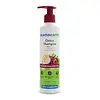What's inside
What's inside
 Key Ingredients
Key Ingredients

 Benefits
Benefits

 Concerns
Concerns

 Ingredients Side-by-side
Ingredients Side-by-side

Water
Skin ConditioningCaprylyl/Capryl Glucoside
CleansingSodium Methyl Cocoyl Taurate
CleansingCocamidopropyl Betaine
CleansingSodium Cocoamphoacetate
CleansingSodium Lauroyl Sarcosinate
CleansingGlycerin
HumectantXanthan Gum
EmulsifyingSalmon Oil
Skin ConditioningKeratin
Skin ConditioningGlyceryl Stearate
EmollientPanthenol
Skin ConditioningPolyquaternium-73
Polyquaternium-10
Tocopherol
AntioxidantSodium PCA
HumectantPotassium Sorbate
PreservativeSodium Gluconate
Skin ConditioningPhenoxyethanol
PreservativeWater, Caprylyl/Capryl Glucoside, Sodium Methyl Cocoyl Taurate, Cocamidopropyl Betaine, Sodium Cocoamphoacetate, Sodium Lauroyl Sarcosinate, Glycerin, Xanthan Gum, Salmon Oil, Keratin, Glyceryl Stearate, Panthenol, Polyquaternium-73, Polyquaternium-10, Tocopherol, Sodium PCA, Potassium Sorbate, Sodium Gluconate, Phenoxyethanol
Phyllanthus Emblica Fruit Extract
HumectantVaccinium Myrtillus Bud Extract
AntioxidantSaccharum Officinarum Extract
MoisturisingAcer Saccharum Extract
Skin ConditioningCitrus Aurantium Dulcis Fruit Extract
MaskingCitrus Medica Limonum Fruit Water
Skin ConditioningDisodium Cocoamphodipropionate
CleansingSodium C14-16 Olefin Sulfonate
CleansingPolysorbate 20
EmulsifyingCocamidopropyl Betaine
CleansingSodium Cocoyl Isethionate
CleansingDecyl Glucoside
CleansingPolyquaternium-10
Citric Acid
BufferingPhenoxyethanol
PreservativeParfum
MaskingCaprylyl Glycol
EmollientDisodium EDTA
Panthenol
Skin ConditioningTocopheryl Acetate
AntioxidantPhyllanthus Emblica Fruit Extract, Vaccinium Myrtillus Bud Extract, Saccharum Officinarum Extract, Acer Saccharum Extract, Citrus Aurantium Dulcis Fruit Extract, Citrus Medica Limonum Fruit Water, Disodium Cocoamphodipropionate, Sodium C14-16 Olefin Sulfonate, Polysorbate 20, Cocamidopropyl Betaine, Sodium Cocoyl Isethionate, Decyl Glucoside, Polyquaternium-10, Citric Acid, Phenoxyethanol, Parfum, Caprylyl Glycol, Disodium EDTA, Panthenol, Tocopheryl Acetate
Ingredients Explained
These ingredients are found in both products.
Ingredients higher up in an ingredient list are typically present in a larger amount.
Cocamidopropyl Betaine is a fatty acid created by mixing similar compounds in coconut oil and dimethylaminopropylamine, a compound with two amino groups.
This ingredient is a surfactant and cleanser. It helps gather the dirt, pollutants, and other impurities in your skin to be washed away. It also helps thicken a product and make the texture more creamy.
Being created from coconut oil means Cocamidopropyl Betaine is hydrating for the skin.
While Cocamidopropyl Betaine was believed to be an allergen, a study from 2012 disproved this. It found two compounds in unpure Cocamidopropyl Betaine to be the irritants: aminoamide and 3-dimethylaminopropylamine. High-grade and pure Cocamidopropyl Betaine did not induce allergic reactions during this study.
Learn more about Cocamidopropyl BetainePanthenol is a common ingredient that helps hydrate and soothe the skin. It is found naturally in our skin and hair.
There are two forms of panthenol: D and L.
D-panthenol is also known as dexpanthenol. Most cosmetics use dexpanthenol or a mixture of D and L-panthenol.
Panthenol is famous due to its ability to go deeper into the skin's layers. Using this ingredient has numerous pros (and no cons):
Like hyaluronic acid, panthenol is a humectant. Humectants are able to bind and hold large amounts of water to keep skin hydrated.
This ingredient works well for wound healing. It works by increasing tissue in the wound and helps close open wounds.
Once oxidized, panthenol converts to pantothenic acid. Panthothenic acid is found in all living cells.
This ingredient is also referred to as pro-vitamin B5.
Learn more about PanthenolPhenoxyethanol is a preservative that has germicide, antimicrobial, and aromatic properties. Studies show that phenoxyethanol can prevent microbial growth. By itself, it has a scent that is similar to that of a rose.
It's often used in formulations along with Caprylyl Glycol to preserve the shelf life of products.
Polyquaternium-10 is an ammonium salt of hydroxyethylcellulose. It is a white and granular powder used as a film-former and anti-static agent.
This ingredient is commonly found in hair conditioning products. According to a manufacturer, its positive charge makes it great for absorbing hair proteins. The manufacturer also states this ingredient helps with curl retention.
For haircare friends: this ingredient is not a silicone.
Learn more about Polyquaternium-10